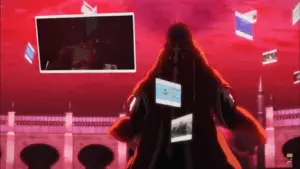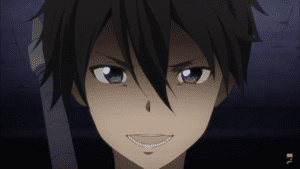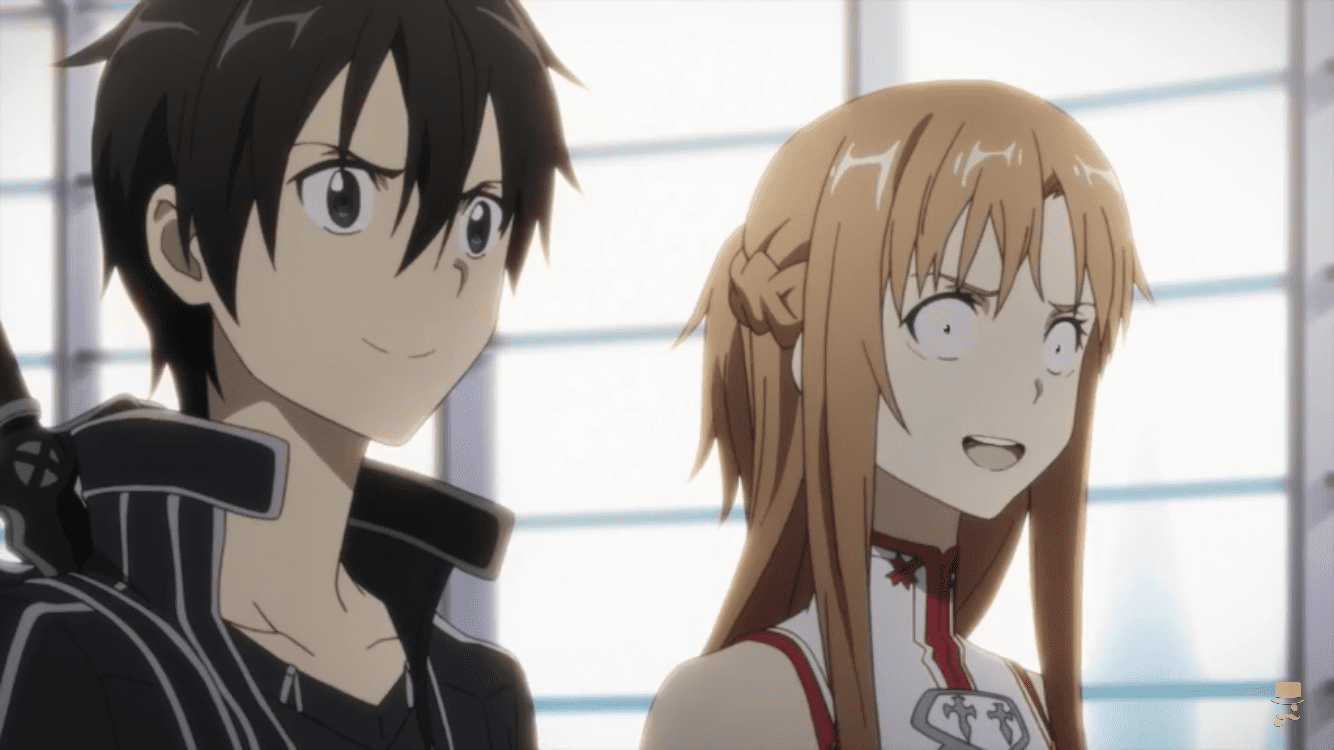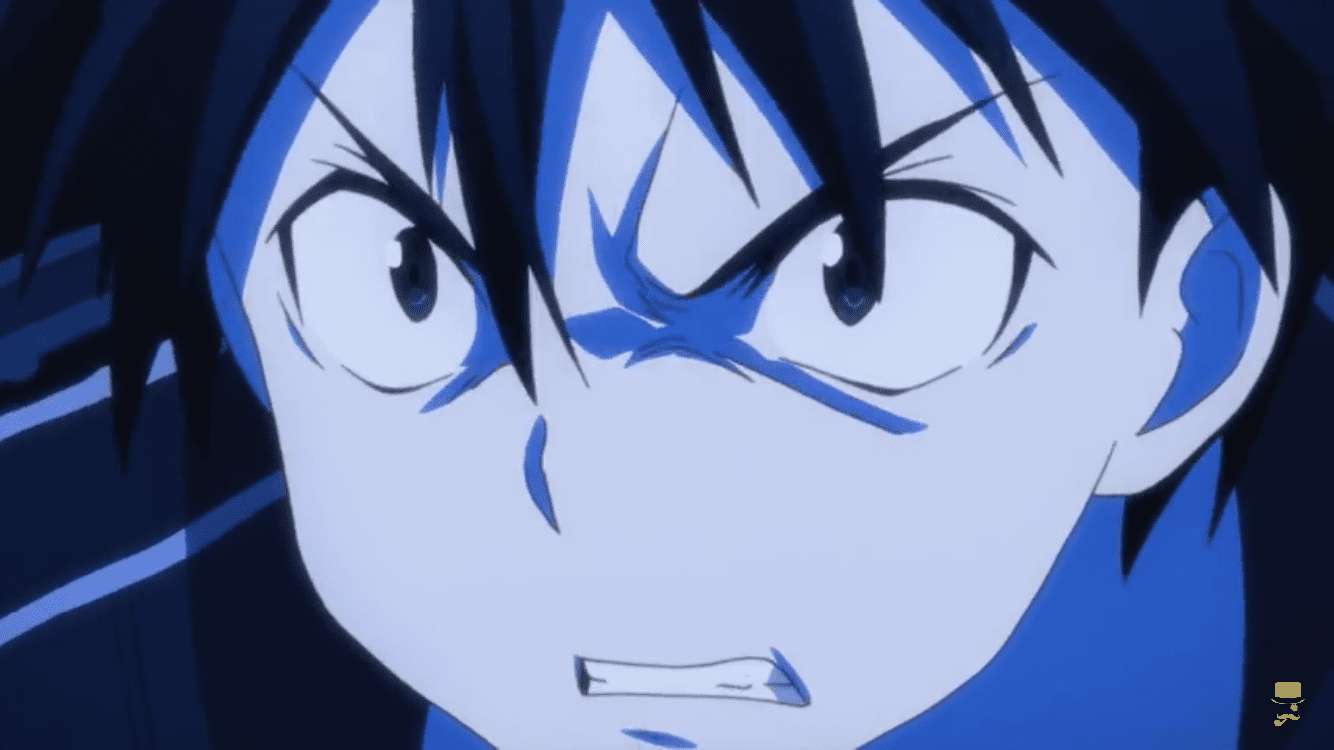Sword. Art. Online.
If you’re ever amongst anime fans and are looking to start an argument, saying those three words is your best bet. Ever since the series took the anime world by storm in 2012, Sword Art Online – or SAO for short – has proven to be one of the most popular, yet divisive anime of the 21st century.
For the unacquainted, SAO is based on a series of light novels by Reki Kawahara. The series is set in the near future, and kicks off on the launch day of the world’s first virtual reality massively multiplayer online role-playing game (VRMMORPG), Sword Art Online. However, when the game’s first ten thousand players log in, they discover that they cannot log out. The game’s creator, Kayaba Akihiko, informs them that no player will be able to log out until all one hundred floors of the game are cleared. What’s more, the Nervegear – the virtual reality headsets used to play SAO – are rigged so that if the players’ HP hits 0, or anyone tries to remove the Nervegear, the device will emit a powerful microwave pulse that will kill them. Essentially, if you die in the game, you die for real.

However, while the premise of SAO is very interesting, the execution…well, it leaves something to be desired. As I said before, SAO has proved a divisive topic for the anime community. Some love the series, while others despise it. Personally, I’m ambivalent. I’m well aware of the franchise’s flaws, but I have noticed a genuine improvement in Kawahara’s writing as the series progresses. However, I’m not here to talk about SAO proper – there are plenty of reviews that have done that already. I’m here to talk about SAO Abridged, by YouTube channel Something Witty Entertainment.
For those of you who are unfamiliar with the concept, an abridged series is when a show (usually an anime)’s original dialogue is removed and replaced to make the show funnier. The most well-known example of this is Martin Billany/LittleKuriboh’s Yu-Gi-Oh! The Abridged Series. YGOTAS frequently mocks and highlights the flaws of its source material such as the overly dramatic tone, logical inconsistencies, and the removal of darker elements in the American dub to make the series more suitable for kids.
Personally, I have two basic criteria for watching an abridged series – it has to be funny, and it has to have good voice acting. So, when I watched SAO Abridged episode one and these criteria were met, I decided to follow the series. The thing is, as time went on, I began to notice something about SAO Abridged. At first, I joked that it was doing a better job at showing how Sachi’s death affected Kirito than the source material. As time wore on though, I noticed this wasn’t an outlier – it was a pattern. With every new episode, the series managed to give emotional poignancy without ever losing the comedic tone, to the point that when the season one finale rolled around, I realised something.
SAO Abridged is more than just a great parody – it’s a brilliant story in its own right.
And here’s why.

Now as far as protagonists go, Kirito doesn’t make for a particularly interesting one. His popularity is understandable, given how he’s wish-fulfilment for the series target audience. A reclusive gamer who’s a lone badass in the virtual world, dressed in all black and attracting women left and right – I’m sure there are many, many members of SAO’s audience who’d love to have that life.
But as far as character development goes…eh. Don’t get me wrong, Reki Kawahara has made some serious strides in his writing as the series has progressed – I could easily write an article on how much I enjoyed Sinon’s character arc in season two – but the character of Kirito still lacks a lot of depth. The only things I found particularly interesting about his character in season one were that he broke away from traditional expectations of male leads – he was willing to cry, and he didn’t look like he’d been pumping himself full of steroids. But there’s a world of difference between an interesting character, and a well-written one.
So where does the abridged version of Kirito, who I’ll call Kirito A, fit into this? Well, I’ve found that one way to measure how well a character is developed is how easy it is to list and describe their primary character traits. With the original Kirito (who I’ll call Kirito O), guess I could say that he’s quiet, calm, and determined, but his characterisation is too weak for me to feel confident with that description.
Kirito A, on the other hand, I can describe in one word with the utmost confidence: asshole. Kirito A is a narcissistic, arrogant, condescending piece of work, and it’s a minor miracle that the entire didn’t team up and kill him. Seriously, he spends most of his first day in Aincrad improving an elaborate story about a pebble just to make fun of Klein.

So why on earth do I watch, let alone praise a series with a main character like this? Well, two reasons. One, rewriting the protagonist as an asshole is kind of how abridged series work. Look at YGOTAS, look at Hellsing Ultimate Abridged – their versions of Yami Yugi and Alucard are awful people, but they’re a delight to watch. Two, this characterisation allows Kirito A to undergo an incredibly poignant character arc.
Yes, you read that correctly. Kirito A’s storyline in SAO Abridged is one of the most emotionally impactful character arcs I’ve ever seen. And I would like to stress that one of the key moments of his character development centre around Klein’s SAO Abridged username, BallsDeep69. No, I am not kidding.
Okay, so how does this all work? Well, Kirito A and Kirito O go on similar character arcs; they start out as loners, then open up to the Moonlight Black cats, shut themselves off after the group is killed, then gradually come out of their shell again after Silica, Lizbeth, and most importantly, Asuna. By the end of the Aincrad arc, they come to understand the value of building relationships with other people. So, acknowledging that these arcs are very similar, what makes Kirito A’s arc so much more poignant? It’s pretty simple, actually – because Kirito A’s character is so well defined, it’s far easier to see how his character grows.

Like I said, Kirito A is an arsehole – but SWE use this characterisation to make his growth throughout the series so much more apparent. When he apologises to someone, it carries genuine emotional weight because of the contrast between his current self and his episode oneself. To give an example, when he apologises to Klein in episode eleven for rejecting his offer to join his guild, it feels genuine because this is the same Kirito who spent most of his first day in Aincrad making fun of Klein. The fact that Kirito is about to engage in a suicidal match against Heathcliff/Kayaba Akihiko makes it all the more moving because Kirito knows this may be the last time he talks to Klein. His final words to Klein aren’t an attempt at mockery, but a genuine apology for his behaviour.
The relationship between Kirito and Klein is probably the easiest way to show why the series works so well. As SAO Abridged is a comedy, it does things like character development through the most ridiculous manner possible. Yet, this is what makes SAO Abridged stand out against other parodies. It doesn’t just make the audience laugh – it uses humour to enhance the effectiveness of its storytelling.
SAO Abridged uses humour in a variety of different ways. Firstly, worldbuilding. There’s a lot of gaming-related jokes throughout the series – Kirito having to buy an ad blocker, the episode two raid group taking a snack break before fighting a boss, and Sachi suffering from lag issues due to poor internet connection. These jokes do more than just make the audience laugh, though. They imply a world outside of the game much like our own. This implication fleshes out the world of SAO Abridged, and make it much more relatable. When we see aspects of our own day-to-day lives in media, whether that be gender, race, class, or in this case, culture, it’s much easier to feel connected to that story, and that’s exactly why the world of SAO Abridged is much richer than in the source material.

Secondly, commentary. Or, more accurately, sassing the source material. It’s no secret that SAO has its fair share of character, plot and pacing issues. It’s also no secret that abridged series makes fun of their source material’s flaws from time to time, with YGOTAS having this down to an art. So, it’s no surprise that there are a few jokes poking fun at SAO. Again though, I’d feel remiss if I didn’t point out the writing behind these jokes. Take the Moonlit Black Cats in episode three. SWE highlights the flaws of SAO but also incorporates gaming humour along the way by making the majority of the ill-fate guild NPCs. While this does lead to some jokes with the NPCs constantly repeating the same dialogue, it’s a very subtle way to point out how in the source material, Tetsuo, Sasamaru, and Ducker essentially had no personality, to the point I couldn’t even remember their names. There’s also the joke regarding Kayaba’s motives in SAO Abridged, but I’ll get to that later.
Finally, character development. This is where the series really shines through the most unconventional methods possible. A running gag throughout SAO Abridged is Kirito making fun of Klein by calling him ‘Balls’ or ‘Ballsy’, a reference to his username, BallsDeep69. While being another nice tie-in to gaming culture, this makes the moments when Kirito calls Klein by his name stand out, because Kirito’s dropping his usual ego trip and being serious. A good comparison would be Brooklyn 99 season four episode sixteen, “Moo Moo”, where Terry gets racially profiled. When the usual comedic tone is taken away, the lack of jokes makes the audience focus more on the subject matter at hand. Thus, when Kirito calls Klein by his actual name, it’s a genuine moment of character development.

This might be the most ridiculous method of character development I’ve ever seen, but it works. When Kirito puts his usual endless mocking on hold and shows genuine friendship towards Klein, his character growth is undeniable. The contrast between his usual narcissism, arrogance and sarcasm and him actually thanking or apologizing to Klein make for incredibly poignant moments. The first one comes in episode three, after the Moonlit Black Cats get wiped out. Kirito’s depression has a much stronger emotional impact because the audience is so used to him being on top of the world and laughing at everyone beneath him. When he says, “Thank you, Klein,” it shows the profound emotional change he’s undergone.
The next time it happens is in episode eight. Episode eight is where SWE really takes the writing to a new level, and was the first time I finished an episode of SAO Abridged laughing, but also moved. It comes right on the heels of Kirito’s battle with the Gleam Eyes, when Kirito’s guilt over Sachi’s death prompts him to save a group of doomed players. During the fight, he makes this little gem of a speech;
“You know something? I REALLY…hate…people. They’re selfish, ignorant, loud, obnoxious, PRICKS with basically no redeeming qualities whatsoever! I mean really! Look at all they’ve achieved! Genocide, global warming, reality TV! It’s just a never-ending parade of failures and fuck-ups! They are, without question, a complete write-off of a species, AND HOW DARE YOU MAKE ME CARE ABOUT THEM!!!!!”

This is a major turning point for Kirito’s character, where his condescending view of everyone else starts to fade. Having him call Klein by his real name is the icing on the cake for this. Bringing up this reoccurring gag marks how much he’s changed since he first met Klein, and how he’s beginning to respect the people around him, and form genuine friendships, perhaps for the first time ever.
The third and final time Kirito uses Klein’s name is right before his fight with Heathcliff/Kayaba Akihiko. As I said earlier, the contrast between Kirito in episode one and in episode eleven gives his apology to Klein for his earlier behaviour emotional weight, and calling him by his real name drives this home.
All of this is done with a joke so juvenile even high schoolers would roll their eyes. Yet SWE makes this joke into an extremely effective way of showing Kirito’s character development throughout the series, to the point where the laughs come second, and the emotions come first. That takes serious skill, and I have nothing but respect for SWE.
So, acknowledging that SAO Abridged uses humour not just for laughs, but to enhance its storytelling, how does SWE’s take on SAO stand up a story?
Honestly? Really, really well.
Where most abridged series simply fun of their source material, SAO Abridged does something different: it restructures the series into a different narrative altogether. True, the main plot beats are the same, but the show streamlines things to focus the narrative into feeling more like an actual story – and a damn good one at that – rather than just a bunch of episodic adventures strung together. It does this by focusing on Kirito, and his character development.

Abridged series often take a lot of liberty editing the source material to tell a steady stream of jokes, but SAO Abridged does something different. True, the jokes are there, but SWE also adds in moments that make Kirito’s character arc function a lot better. His flashbacks to Sachi’s death are sprinkled throughout the series, often in key moments that see Kirito open up to someone, such as when he meets Silica, or when he snaps out of his holier than thou attitude before fighting the Gleam Eyes. These flashbacks make these moments feel more like a natural progression of Kirito’s arc, and the emotional beats land a lot better because they’re earned.
Like I said, this really starts to come to fruition in the later episodes, particularly in his interactions with Asuna. Now Abridged Asuna is…well, to put it mildly, she’s a bit of a sociopath. She’s emotionally manipulative, she’s a bit sadistic and abusive (the one part of the series I’m uncomfortable with), and she flat-out murders people. So, when the two are together, the constant piss-taking and arguing is not exactly a surprise. What is a surprise, is how well this leads into their romance.
In the source material, Kirito and Asuna’s romance doesn’t have a lot to it. They just kind of get together and that’s it. Here though, the relationship feels earned and realistic. These two morons have absolutely how to be in a relationship, which is pretty much what you’d expect from two teenagers. In episode ten, after they get married, it becomes abundantly clear that they no idea what they’re doing. Both of their internal monologues reveal they’re trying to get the other to confess that the relationship was a bad idea, and when Yui comes along, it gets turned up to eleven.
“…the most broken, sociopathic players I had ever laid eyes on. Less people than a…loose collection of character defects.” – Yui, Episode 10

After spending episodes using Yui as a pawn to avoid talking about their problems, her ‘death’ gets them to have a proper conversation about their relationship. And this is brilliant because it forces both of them to break out of their shells even more and leads them to come closer together as a couple. The final scene of episode ten, where they actually have a heart-to-heart conversation was incredibly tender and gave the episode a sense of accomplishing something. Relationships aren’t easy and they require a lot of work and communication. Showing Kirito and Asuna learning how to communicate with one another is so much more real and meaningful than ‘protagonist gets the girl’.
This is why SAO Abridged works. Not only is it hilarious, the character growth feels earned and leads to some genuinely heartfelt scenes, and nowhere is this done better than in the season one finale, episode eleven. I’ve already gone over how meaningful the moment with Klein is – and that’s just one part of the episode.
When Kirito realises that Heathcliff is Kayaba, the antagonist gives a…well, I’d call it a speech but it’s more of a tantrum to be perfectly honest. He goes off on the players and how they’ve made his life hell, despite, you know, being the one who stuck them in the game in the first place. When Kirito cuts him off and stands up for the people who he’s mocked for the last two years, it shows how far he’s come. He’s definitely still an asshole, but he genuinely cares for the people around him. When he steps forward to fight Kayaba in the original, it’s alright. When he does in SAO Abridged, the personal journey Kirito has gone on gives the moment weight, especially when the series’ theme song starts playing.

Most abridged series use a shortened version of the original’s opening them as their own opening theme, but SAO Abridged does it a bit differently. SWE uses the song This is War, and that’s what plays during the final battle. Now while it’s a great song, it also acts as a reminder of all of the events Kirito has gone through, and makes the battle feel like the natural culmination of what’s come before. Not to mention, it starts playing when this comes up in Kirito’s internal monologue;
“Oh, don’t you worry about me Kayaba. This won’t be anything like last time. Because now…I’ve got something worth fighting for!”
The source material never comes close to this level of emotion, and that’s why SAO Abridged is often regarded as not just an improvement, but a great story in its own right. It does everything SAO tried to achieve but didn’t, and then some. It rewrites Kirito and Asuna into far more interesting versions of themselves with arcs that carry weight and leave you genuinely moved when Kirito tells Asuna he loves her. It restructures the story to make these characters arc work, and fixes gaping plot holes along the way such as Kayaba’s explanation for creating the game, which goes from “I forgot” to a story of sleep deprivation causing him to create a death game to appease critics.
Which is completely ridiculous, to be clear, but this is SAO Abridged, where jokes make previously shallow characters into multi-faced individuals. At the end of the day, this is a comedy and a brilliant one at that. From the cleverly constructed jokes that demonstrate character development and worldbuilding to the ridiculous ones such as Don Fluffles, the humour does so much more than make the audience laugh – it improves the quality of the story.
When the credits for season one rolled, I knew I’d found something truly special. And I can’t wait to see what comes next.

Images courtesy of Something Witty Entertainment and YouTube.

